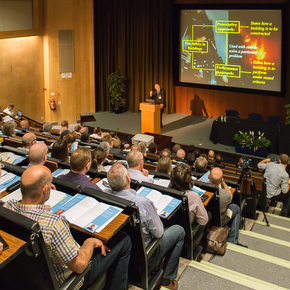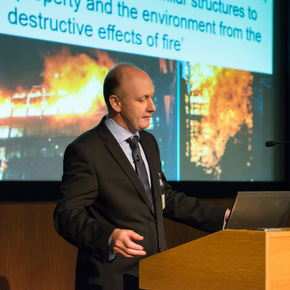
BRE fire research conference focus on safety, protection and regulations
BRE Fire Research Conference highlights the latest research shaping the future of fire safety design and management
BRE Fire Research Conference
More than 150 delegates from across the UK and overseas attended the 2016 conference held on the 9th June at BRE’s headquarters.
Delegates included architects, engineers, building control officers, local authorities, housing associations, manufacturers, fire safety consultants, and representatives from the NHS, fire services, academia and insurance industry.
Experts discussed newly published and current BRE research related to both passive and active fire protection, ranging from roof void compartmentation and fire safety in open plan flats, to sprinkler systems in housing and the problem of false fire alarms.
Keynote lecture
 Professor Colin Bailey, Deputy President and Deputy Vice-Chancellor of the University of Manchester and an international authority in structural fire engineering.
Professor Colin Bailey, Deputy President and Deputy Vice-Chancellor of the University of Manchester and an international authority in structural fire engineering.
Professor Bailey discussed the legacy of large-scale fire testing at BRE Cardington which yielded critical data on structural fire behaviour that continues to inform safer, more robust and more cost effective design solutions.
Together with real fire data and the development of codified performance-based approaches, the work has delivered tools to better predict a building’s performance during a fire and more accurately assess risks.
Professor Bailey argued that performance-based design employing advanced models can better respond as we push the limits of structural engineering with the use of longer, thinner sections and new materials. A prescriptive approach dictated by building standards and system fire testing is less adaptable to the impacts of new technology and materials.
Referring to fire data on multi-storey structures, he explained that while any visible degree of vertical displacement in the beams will typically necessitate replacement, it does not lead to building collapse – a point that has been acknowledged by insurers. Hence, performance gains do not necessarily follow from an increase in beam fire protection, with evidence showing that between 40-55% of beams in multi-storey steel structures can be left unprotected. A performance-based approach therefore provides the confidence to target fire protection where it is required.
Main Speaker Presentations
Links to presentations given by nine experts from across BRE’s certification, structural and fire safety teams, gave an insight into other landmark research and opinion-leading projects.
- Compartmentation in roof voids – doing it right – Tom Lennon
- Sprinkler systems in housing in Wales – Dr Corinne Williams
- Live investigations of false alarms in buildings – Raman Chagger
- Wireless fire detection – a solution for prisons? – Steve Manchester
- Local area fire protection using automatic suppression – Nigel Firkins
- Evaluation of fire performance through real fire incident data – Dr David Crowder
- Open-plan flats and fire safety – Dr Chris Salter
- Fire risk assessment and why it matters – Martin Shipp
- Managing industrial hazards – Rob Lucas
Link to Fire Research projects and guidance documents
Link to 2017 Fire Research conference details
Latest news

28th February 2025
Passivent ventilation solutions are top of the class
Passivent has supplied a combination of Hybrid Plus2 Aircool ventilators and Hybrid Plus Airstract roof ventilation terminals for a new London primary school.
Posted in Air Conditioning, Articles, Building Industry News, Building Products & Structures, Building Services, Case Studies, Ceilings, Facility Management & Building Services, Heating, Ventilation and Air Conditioning - HVAC, Restoration & Refurbishment, Retrofit & Renovation, Roofs, Sustainability & Energy Efficiency, Ventilation, Walls
28th February 2025
Troldtekt: New acoustic liner ensures good acoustics and easy handling
Both a building’s users and its developers have a good reason to get excited about the new Troldtekt Plus 25 panels. This specially developed acoustic panel sets a high standard for both sound absorption and building efficiency.
Posted in Acoustics, Noise & Vibration Control, Articles, Building Industry News, Building Products & Structures, Building Services, Building Systems, Ceilings, Facility Management & Building Services, Floors, Innovations & New Products, Insulation, Interior Design & Construction, Interiors, Restoration & Refurbishment, Retrofit & Renovation, Timber Buildings and Timber Products, Walls
28th February 2025
InstallerSHOW 2025 – Registration is now OPEN!
Building on the success of last year, InstallerSHOW is returning to the NEC from the 24th to the 26th of June…
Posted in Articles, Building Industry Events, Building Industry News, Building Products & Structures, Building Services, Exhibitions and Conferences, Health & Safety, Retrofit & Renovation, Seminars, Sustainability & Energy Efficiency
28th February 2025
ABLOY securing Helsinki’s heritage and Croatia’s waste management
ABLOY, part of ASSA ABLOY Group, has redefined its brand, focusing on the value it brings to customers around the world…
Posted in Access Control & Door Entry Systems, Architectural Ironmongery, Articles, Building Industry News, Building Products & Structures, Building Services, Case Studies, Doors, Facility Management & Building Services, Health & Safety, Retrofit & Renovation, Security and Fire Protection
 Sign up:
Sign up: